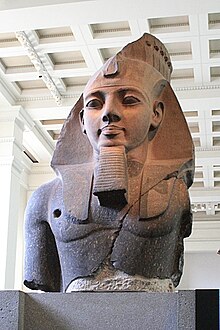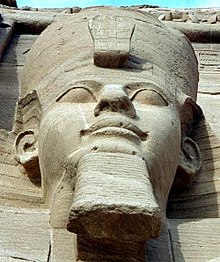Ramesses 2-sè
Ramesses 2-sè (iok. chiân 1303 nî – chiân 1213 nî 7 goe̍h ia̍h 8 goe̍h) sī Kó͘ Ai-ki̍p Tē-19 Ông-tiâu ê pharaoh. I it-poaⁿ hông jī-ûi sī siāng kài iú-le̍k ê Ai-ki̍p pharaoh.
| Ramesses 2-sè | |
|---|---|
| Ramesses tāi-tè | |
 Statue of Ramesses II, the ‘Younger Memnon’. From the Ramesseum, Thebes, Egypt, 19th Dynasty, about 1250 BC. British Museum, London. | |
| Pharaoh | |
| Chāi-ūi | chiân 1279 nî–chiân 1213 nî (Tē-19 Ông-tiâu) |
| Chêng-jīm | Seti 1-sè |
| Kè-jīm | Merneptah |
| Phoè-ngó͘ | Nefertari, Isetnofret, Maathorneferure, Meritamen, Bintanath, Nebettawy, Henutmire |
| Kiáⁿ-jî | Amun-her-khepsef, Ramesses, Pareherwenemef, Khaemwaset, Merneptah, Meryatum, Bintanath, Meritamen, Nebettawy, Henuttawy (List of children of Ramesses II) |
| Lāu-pē | Seti 1-sè |
| Lāu-bú | Tuya |
| Chhut-sì | c. chiân 1303 nî |
| Kòe-sin | chiân 1213 nî |
| Bōng | KV7 |
| Kì-liām-pi | Abu Simbel, Abydos,[4] Ramesseum, Luxor,[5] Karnak[5] |

Pī-chù
siu-kái- ↑ 1.0 1.1 1.2 1.3 1.4 1.5 Leprohon (2013), pp. 114-115.
- ↑ 2.0 2.1 Clayton 1994, p. 146.
- ↑ 3.0 3.1 3.2 Tyldesly 2001, p. xxiv.
- ↑ "Mortuary temple of Ramesses II at Abydos". goân-loē-iông tī 22 December 2008 hőng khó͘-pih. 28 October 200 khòaⁿ--ê.
- ↑ 5.0 5.1 Anneke Bart. "Temples of Ramesses II". goân-loē-iông tī 28 April 2008 hőng khó͘-pih. 23 April 2008 khòaⁿ--ê.
Chham-khó chu-liāu
siu-kái- Balout, L.; Roubet, C.; Desroches-Noblecourt, C. (1985). La Momie de Ramsès II: Contribution Scientifique à l'Égyptologie.
- Bietak, Manfred (1995). Avaris: Capital of the Hyksos – Recent Excavations. London: British Museum Press. ISBN 978-0-7141-0968-8.
- von Beckerath, Jürgen (1997). Chronologie des Pharaonischen Ägypten. Mainz: Philipp von Zabern.
- Brand, Peter J. (2000). The Monuments of Seti I: Epigraphic, Historical and Art Historical Analysis. NV Leiden: Brill. ISBN 978-90-04-11770-9.
- Brier, Bob (1998). The Encyclopedia of Mummies. Checkmark Books.
- Clayton, Peter (1994). Chronology of the Pharaohs. Thames & Hudson.
- Dodson, Aidan; Dyan Hilton (2004). The Complete Royal Families of Ancient Egypt. Thames & Hudson. ISBN 978-0-500-05128-3.
- Grajetzki, Wolfram (2005). Ancient Egyptian Queens – a hieroglyphic dictionary. London: Golden House Publications. ISBN 978-0-9547218-9-3.
- Grimal, Nicolas (1992). A History of Ancient Egypt. Oxford: Blackwell. ISBN 978-0-631-17472-1.
- Kitchen, Kenneth (1983). Pharaoh Triumphant: The Life and Times of Ramesses II, King of Egypt. London: Aris & Phillips. ISBN 978-0-85668-215-5.
- Kitchen, Kenneth Anderson (2003). On the Reliability of the Old Testament. Michigan: William B. Eerdmans Publishing Company. ISBN 978-0-8028-4960-1.
- Kitchen, Kenneth Anderson (1996). Ramesside Inscriptions Translated and Annotated: Translations. Volume 2: Ramesses II; Royal Inscriptions. Oxford: Blackwell Publishers. ISBN 978-0-631-18427-0. Translations and (in the 1999 volume below) notes on all contemporary royal inscriptions naming the king.
- Kitchen, Kenneth Anderson (1999). Ramesside Inscriptions Translated and Annotated: Notes and Comments. Volume 2: Ramesses II; Royal Inscriptions. Oxford: Blackwell Publishers.
- Kuhrt, Amelie (1995). The Ancient Near East c. 3000–330 BC. 1. London: Routledge.
- O'Connor, David; Eric Cline (1998). Amenhotep III: Perspectives on his reign. University of Michigan Press.
- Putnam, James (1990). An introduction to Egyptology.
- Rice, Michael (1999). Who's Who in Ancient Egypt. Routledge. ISBN 978-0-415-15448-2.
- Ricke, Herbert; George R. Hughes; Edward F. Wente (1967). The Beit el-Wali Temple of Ramesses II.
- Rohl, David M. (1995). Pharaohs and Kings: A Biblical Quest (illustrated, reprint pán.). Crown Publishers. ISBN 978-0-517-70315-1.
- RPO Editors. "Percy Bysshe Shelley: Ozymandias". University of Toronto Department of English. University of Toronto Libraries, University of Toronto Press. goân-loē-iông tī 10 October 2006 hőng khó͘-pih. 18 September 2006 khòaⁿ--ê.
- Siliotti, Alberto (1994). Egypt: temples, people, gods.
- Skliar, Ania (2005). Grosse kulturen der welt-Ägypten.
- Stieglitz, Robert R. (1991). "The City of Amurru". Journal of Near Eastern Studies. 50 (1): 45–48. doi:10.1086/373464.
- Tyldesley, Joyce (2000). Ramesses: Egypt's Greatest Pharaoh. London: Viking/Penguin Books.
- Westendorf, Wolfhart (1969). Das alte Ägypten (ēng Tek-gí).
- Chhem, RK; Schmit, P; Fauré, C (October 2004). "Did Ramesses II really have ankylosing spondylitis? A reappraisal". Can Assoc Radiol J. 55 (4): 211–7. PMID 15362343.
- The Epigraphic Survey, Reliefs and Inscriptions at Karnak III: The Bubastite Portal, Oriental Institute Publications, vol. 74 (Chicago): University of Chicago Press, 1954
- Leprohon, Ronald J. (2013). The Great Name: Ancient Egyptian Royal Titulary (ēng Eng-gí). SBL Press. ISBN 978-1-58983-736-2.
Kî-thaⁿ chu-liāu
siu-kái- Hasel, Michael G (1994). "Israel in the Merneptah Stela". Bulletin of the American Schools of Oriental Research. 296 (296): 45–61. doi:10.2307/1357179. JSTOR 1357179.
- Hasel, Michael G. 1998. Domination and Resistance: Egyptian Military Activity in the Southern Levant, 1300–1185 BC. Probleme der Ägyptologie 11. Leiden: Brill Publishers. ISBN 90-04-10984-6
- Hasel, Michael G. 2003. "Merenptah's Inscription and Reliefs and the Origin of Israel" in Beth Alpert Nakhai (ed.), The Near East in the Southwest: Essays in Honor of William G. Dever, pp. 19–44. Annual of the American Schools of Oriental Research 58. Boston: American Schools of Oriental Research. ISBN 0-89757-065-0
- Hasel, Michael G (2004). "The Structure of the Final Hymnic-Poetic Unit on the Merenptah Stela". Zeitschrift für die alttestamentliche Wissenschaft. 116: 75–81. doi:10.1515/zatw.2004.005.
- James, T. G. H. 2000. Ramesses II. New York: Friedman/Fairfax Publishers. A large-format volume by the former Keeper of Egyptian Antiquities at the British Museum, filled with colour illustrations of buildings, art, etc. related to Ramesses II
Goā-pō͘ liân-kiat
siu-kái| Pún bûn-chiuⁿ sī chi̍t phiⁿ phí-á-kiáⁿ. Lí thang tàu khok-chhiong lâi pang-chō͘ Wikipedia. |